Toyota Sprinter
| Toyota Sprinter | |
|---|---|
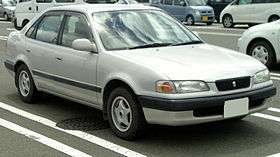 | |
| Overview | |
| Manufacturer |
Toyota NUMMI |
| Also called |
Chevrolet Nova Geo Prizm Toyota Corolla Sprinter Holden Nova |
| Production | 1968–2001 |
| Assembly | Toyota City, Japan |
| Body and chassis | |
| Class |
Subcompact (1968–1991) Compact (1991–2001) |
| Related |
Toyota Corolla Toyota Sprinter Trueno |
| Chronology | |
| Successor |
Toyota Allex Toyota Voltz |
The Toyota Sprinter was a compact car manufactured by Toyota as a variant of the Toyota Corolla. Exclusively sold in the Japanese domestic market, the Sprinter was aimed to be sportier than its Corolla sibling, with the Sprinter being sold at the Toyota Vista Store (formerly known as Toyota Auto Store before 1980) while the Corolla was sold at the eponymous Toyota Corolla Store, which focused on economical cars compared to the more upmarket Vista store.
The Sprinter is notable for being used as the base vehicle for two joint projects between Toyota and General Motors in the United States and Australia. From 1984 to 2002, variants of the Sprinter were manufactured by NUMMI in Fremont, California, known as the Chevrolet Nova (1984–1988), Geo Prizm (1988–1997), and Chevrolet Prizm (1997–2002). The Holden Nova was manufactured by United Australian Automobile Industries from 1989 to 1996.
Each generation of the Corolla had a corresponding Sprinter sibling, until the introduction of the Corolla E140 in 2000. The Sprinter was directly replaced by the Toyota Allex and NUMMI would also commence export of the Corolla-derived Pontiac Vibe hatchback from the United States to the Japanese domestic market badged as the Toyota Voltz. Both were sold at the Toyota NETZ Store, which succeeded the Toyota Vista dealer network.
First generation—E10 series
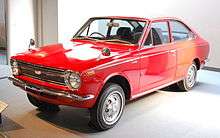
The first generation Sprinter was introduced in March 1968 as a fastback version of the first generation Corolla, and sold at Japanese dealership sales channel called Toyota Auto Store. This was the only version to include the word "Corolla" in its name. Like the rest of the Corolla range, the 1077 cc K engine was upgraded to the 1166 cc 3K engine in September 1969. The Corolla was sold at a different dealership in Japan called Toyota Corolla Store.
Second generation—E20 series
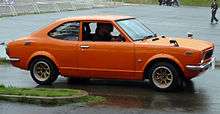
In May 1970, the Sprinter was released as a variation of the second generation Corolla coupe. Toyota had promised its Toyota Corolla store dealers in Japan that they would receive exclusive rights to sell the Corolla. In order to sell through the Toyota Auto Store dealer network, the Sprinter was no longer called a Corolla, even though the differences were mostly cosmetic.
In Japan, the 3K engine was supplemented by a 1407 cc T engine in September 1970. Some markets received the 1588 cc 2T engine in March 1972. With the twincam 2T-G engine the vehicle was known as the Sprinter Trueno. As special model called the Sprinter Trueno J had everything the Trueno had except it used the single cam, twin carburetor 2T-B engine.
Third generation—E40, E60 series
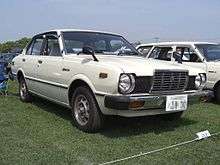
1974 brought the third generation Sprinter based on the third generation Corolla coupe, 2 door sedan, 4 door sedan and liftback. Once again, the differences between the Corolla and Sprinter were mostly cosmetic. Sedans received a more formal upright grill, while the coupe and liftback received a sleeker, aerodynamic looking frontal treatment.
The Corolla's were given E30-38 codes while the Sprinter's were given corresponding E41-47 codes. When the Corolla range received a minor update in March 1974 to become the E50-55 series, the Sprinter received a corresponding update to become the E60 series. In 1978, the Sprinter saw a competitor introduced by Nissan called the Pulsar.
Fourth generation—E70 series
The 1979 fourth generation Sprinter was based on the fourth generation Corolla coupe, 2 door sedan, 4-door sedan and liftback. As before, the differences were cosmetic—the Corollas had a simpler treatment of the grill, head lights and tail lights while the Sprinter used a slightly more complex, sculpted treatment.
Images of this generation can be found here
Fifth generation—E80 series

.jpg)
The fifth generation Sprinter was based on the 1983 fifth generation Corolla range. Like the Corolla, the model line was split into FWD and RWD models. This was the last generation of Sprinters to have RWD, so it remains a favourite of sports car enthusiasts—particularly in drifting. Fame was brought to this model by its appearance in the Initial D Japanese animation.
The four door sedan and the five door liftback were sold in North America under the resurrected name of Chevrolet Nova, the first of several Toyotas built by General Motors under license at NUMMI.
The Japanese market Sprinter was available as the following models:
| Type | Code | Layout | Engines |
|---|---|---|---|
| 4-door sedan | EE80, AE80, AE81, AE82, CE80 | FWD | 2E, 3E, 2A, 4A-FE, 4A-GEU, 1-C |
| 5-door liftback | EE80, AE80, AE81, AE82 | FWD | 2E, 3E, 4A-FE, 4A-GE |
| 2 door coupe | AE85, AE86 | RWD | 3A-U, 4A-GEU, 4A-C, 4A-FE |
| 3-door liftback | AE85, AE86 | RWD | 3A-U, 4A-GEU, 4A-C, 4A-FE |
The AE82 Sprinter sedan had slightly different head lamps compared to the AE82 Corolla, 4 side windows, inclined c-pillar, different tail lamps the boot was placed a little higher and front aero grills were like the AE86 Levin. It had an overall similarity with the AE86 Levin coupe. The RWD Sprinter came with pop-up head lamps (the Corolla had fixed head lamps) and the front bumper was raised a little to accommodate them. The US Corolla GTS shared the head lamps with the Japanese market AE86 Sprinter but with small differences such as lower lift height and US globe fittings. The Sprinter sold in Australia was actually identical to a Japanese market Corolla in all of its specifications (e.g. no pop-up head lamps, Japanese market tail lamps).
FWD grades:
- ZX, SX
- DX,Special DX
- XL, Super XL, XL Lisse
- SE, SE Saloon, Riviere
- SR, GT
RWD grades:
- XL, SE, SR, GT, GTV, GT Apex, Black Limited
Sixth generation—E90 series
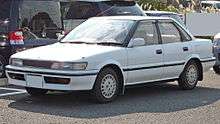

The sixth generation Sprinter was shared with the sixth generation Corolla range, introduced in May 1987. They were offered as FWD & full-time 4WD. The Sprinter was offered as a sedan, coupe, 5-door liftback called Sprinter Cielo, and station wagon named Sprinter Carib.
The sedan and liftback had the same front ends but different rear ends. The JDM market Sprinter Trueno coupe had retractable head lamps, but in this generation the RWD model was discontinued and all coupes were FWD. It was the based for the American Corolla coupe. In the United States, the Sprinter sedan and liftback with slightly different front end were sold as Geo Prizm.
The E9X frames were offered with a variety of engines:
| Code | Capacity | Comment |
|---|---|---|
| 2C | 1997 cc | CE95 — 2.0L normally aspirated diesel |
| 2E | 1295 cc | |
| 3E | 1456 cc | |
| 4A-FE | 1587 cc | DOHC |
| 4A-GE | 1587 cc | 16 valve, DOHC, GT grades only |
| 7A | 1762 cc | |
| 4A-GZE (16v) | 1587 cc | 16 valve, supercharged, 163 hp (122 kW), DOHC |
Out of all these engines the 4A-GE 20v Silver Top was a revolutionary engine when it was offered in 1991, with features like VVT, individual throttle bodies (ITB's), a compression ratio of 10.8:1 and 5-valve per cylinder. This helped the car to accelerate from 0–100 km/h in approximately 6 seconds and reach a top speed of over 200 km/h. A 5-valve-per-cylinder engine was unusual for the time, though Mitsubishi also offered a 5-valve vehicle in the Minica Dangan ZZ-4 in 1989.[1]
- Exterior
The E90 models started production in 1988 and ended in mid-1991; like previous models it got mid-life facelifts called (ZENKI) 1st face and (KOUKI) 2nd face. The GT versions, as usual, were given a front lip and a spoiler at the back.
The Sprinter was available as the following models:
| Type | Code | Layout |
|---|---|---|
| sedan, coupe, liftback | EE90, AE91, EE91, AE92 | FWD |
| sedan, wagon | AE93, AE94, AE95 | 4WD |
| sedan | CE95 | 4WD |
The Sprinter was available in the following grades:
- MX, MX saloon, SE, XL, GT, AV-I, AV-II, RVS, GT Apex (other)
Seventh generation—E100 series
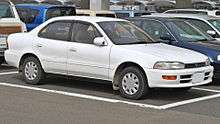

The seventh generation Sprinter was shared with the seventh generation Corolla range introduced in June 1991. This platform continued to be produced in North America as the Geo Prizm sedan, as the hatchback body style was discontinued.
For this generation only, Toyota introduced the 4-door hardtop sedan (with frameless door windows) called the Sprinter Marino.
Eighth generation—E110 series

The eighth generation Sprinter was shared with the eighth generation Corolla range from May 1995. This is the last time Toyota used the Sprinter badge. After this, Toyota used the Allex badge. The E110 Sprinter was only marketed in the Japanese market as a sedan. Its exterior was similar to the E110 Corolla but there were small differences like the Sprinter badges in the front grill and the interior. This bodystyle continued in North America, with some minor changes, as the Chevrolet Prizm, when the Geo brand was discontinued.
In Japan, the Sprinter Carib was based on the 5-door 1.6 L (1,587 cc) station wagon. This version came standard with electric windows, air bags for both driver and front passenger and automatic transmission; several engine options were available. Externally it could be distinguished from the Corolla by its black, rather than body-coloured upper bumper and side mouldings and door handles. In front, new headlights and air intake mouldings and radiator intake openings were used, often with a "Carib" nameplate. The Carib was also fitted with a spoiler, with an integrated brake light, above the rear window on the back hatch, and some were fitted with roof rails. A "Carib" decal was used on the right, rear window in place of "Corolla". Some versions of the Carib were four-wheel drive. Hiroshi Okamoto designed the front exterior design.[2]
- Engines
2E-E, 5A-FE, 4A-FE, 4A-GE (16-valve), 4A-GE (20-valve), 2C
References
- ↑ "AutoSpeed - Mighty Minica ZZ-4". Autospeed. 2005-10-05. Retrieved 2012-01-12.
- ↑ "岡本浩志" [Okamoto Hiroshi] (in Japanese). Chiba University. 2006. Retrieved 2016-06-21.
External links
| Wikimedia Commons has media related to Toyota Sprinter. |